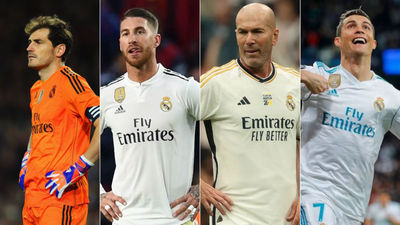Real Madrid CF, with 13 European Champion Clubs' Cup victories, is the continent's most decorated team, but they had a five-title head start from the world's best team from 1956 to 1960. Real Madrid was named FIFA Club of the Century on December 11, 2000, after receiving 42.35 per cent of the voting, and the FIFA Centennial Order of Merit on May 20, 2004. On May 11, 2010, the IFFHS named the club Best European Club of the 20th Century.
Coaches: Jose Villalonga (1955-57), Luis Carniglia (1957-59) & Miguel Munoz (1959 & 1960)
Trophies: 5 European Cups (1955 to 1960), 2 La Liga titles (1956–57, 1957–58) 1 Intercontinental Cup (1960)
Star Players: Di Stefano, Puskas, Kopa, Gento, Santamaria, Del Sol
1955-60 Real Madrid is without a doubt the most successful, having won the European Cup five times in a row since its foundation. Bernabeu, Bedrignan, and Gusztav Sebes created the UEFA Champions League in 1955, based on an idea proposed by Gabriel Hanot, a French sports journalist and editor of L'Equipe. Bernabeu, Bedrignan, and Gusztav Sebes created a tournament for the champion teams around Europe, by invitation, that would eventually become the UEFA Champions League. In an era when football science was still in its infancy, large signings were perhaps as important as tactics, but one thing was certain: Madrid's onslaught swamped all comers. Madrid scored 112 goals in five consecutive European Cup winning campaigns, scoring 20, 20, 25, 16, and 31 goals.
Di Stefano, who usually started as a centre-forward but used to move to midfield and even help to organise the defence, is the team's common connection and best player. When Ferenc Puskas joined the team in 1958 after defecting from communist Hungary, Gento became one of the best left-wingers in history, and the team gained a star to rival Di Stefano. He was a terrific goalscorer who played inside left but regularly went into space in the box. Raymond Kopa, the renowned French playmaker, was forced to move to the right side, where he excelled. Santamaria was the rock in central defence, complementing these explosive players.
The golden era required continuity on the field; Di Stéfano scored in all five of the team's final victories, but the span was overseen by three different coaches. The first two victories were led by Villalonga before Argentinian Luis Antonio Carniglia oversaw the 1958 and 1959 campaigns. Miguel Muoz, a midfielder who played in Madrid's first three European Cup victories, was on the bench for the 1960 and 1966 triumphs, but while his side dominated Spain in the 1960s, philosophical shifts elsewhere meant no one could dominate European success in the same way again.
During the 1955–56 season, the European Cup was held for the first time. Sixteen teams (some by invitation) competed: Milan (Italy), AGF Aarhus (Denmark), Anderlecht (Belgium), Djurgården (Sweden), Gwardia Warszawa (Poland), Hibernian (Scotland), Partizan (Yugoslavia), PSV Eindhoven (Netherlands), Rapid Wien (Austria), Real Madrid (Spain), Rot-Weiss Essen (West Germany), Saarbrücken (Saar), Servette (Switzerland), Sporting CP (Portugal), Stade de Reims (France), and Vörös Lobogó (Hungary).
On June 13, 1956, the first final took place at the Parc des Princes between Stade de Reims and Real Madrid. With goals from Alfredo Di Stéfano and Marquitos, as well as two goals from Héctor Rial, the Spanish team fought back from behind to win 4–3. The following season, Real Madrid successfully defended the trophy against Fiorentina at their home stadium, the Santiago Bernabéu. Real Madrid overcame the Italians with two goals in six minutes after a scoreless first half. Milan failed to capitalise in 1958 after going ahead twice on the scoreboard just to have Real Madrid equalize. The final, which was contested at Heysel Stadium, went to extra time, with Francisco Gento scoring the game-winning goal to ensure Real Madrid's third consecutive victory.
Real Madrid defeated Stade Reims 2–0 in the 1959 final at the Neckarstadion, in a repetition of the first final. Eintracht Frankfurt of West Germany became the first non-Latin team to reach the European Cup final. The 7-3 win over Eintracht on May 18, 1960, in front of 127,621 fans in Scotland, may have been the absolute pinnacle. Ferenc Puskás scored four goals and Di Stéfano had a hat trick. Rogelio Domnguez; Marquitos, José Santamara, Pachn; Vidal, Zárraga; Canario, Luis del Sol, Di Stéfano, Puskás, Francisco Gento were the starting XI named by liza Miguel Munoz, who became the first person to win the European Cup as both a player and a manager.
Here’s what Sir Alex Ferguson said about the legendary team:
"In the [1960] semi-final, Eintracht Frankfurt beat Rangers and we looked upon Eintracht as almost certain to win the cup - but Real Madrid were a special team. I had the pleasure as a young man of being influenced by the great Real Madrid and Di Stéfano. His head was up all the time. He was such a fantastic footballer."
Real Madrid's rule came to an end in the first round of the 1960–61 season, when bitter rivals Barcelona dethroned them. Barcelona, on the other hand, would lose 3–2 in the final to Benfica of Portugal at Wankdorf Stadium. This was a star-studded squad, an idea that has shaped the club to this day. In that regard, this team has a lot in common with the Galacticos team from the early 2000s. This team, on the other hand, was considerably more balanced and successful.











